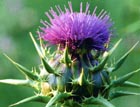The Thorny Beauty of Thistles
Now is the time of year that the thistles start casting their seeds to the wind, and it's a wonderful sight, finds Mary Anne Robb


The clarity of the air changes as autumn puts a foot in the garden door. On days like these, there is no birdsong except for the harsh cry of young birds of prey, and the soft cooing of the wood pigeons. This is also thistle time, when they cast their seeds to the wind.
Thistle is a name widely applied to herbaceous plants with spiny leaves, and flowers usually in rounded heads; but, strictly speaking, a thistle belongs to the daisy tribe the family Compositae, sometimes known as Asteraceae. Some of them have charming country names such as sow thistle, melon thistle, milk thistle and melancholy thistle. Most are easy to propagate from seed in a well-drained gritty compost and, winter or summer, there are always thistles to be found in the garden in some stage of development.
I grew my first (and still my favourite) one, Silybum marianum, by chance, as it was blown in on the wind. I was entranced by its spectacular form: huge, dark leaves marbled with large, white markings. S. marianum is sometimes known as Our Lady's milk thistle, blessed thistle or holy thistle. A biennial which can reach 4ft tall, it grows wild in Europe, Asia, and North Africa, and is easy to grow in any ordinary soil. Originally, the plant was grown for its root which was boiled as a pot herb; the flowerheads are like miniature artichokes (and can be treated like them), and the leaves used to furnish a salad - what more can you ask of a thistle?
I first saw Berkheya purpurea some 20 years ago, on a plant-hunting expedition in South Africa with the botanists Martyn Rix and Jamie Compton. It was growing high on a rocky slope in the Drakensberg mountains, and was named in honour of M. J. L. de Berkhey, a Dutch botanist. We propagate ours by dividing up the plant in the autumn, or by taking basal cuttings. The whole plant, which can grow to 3ft, is very prickly, but its flowers are the prettiest pale mauve, surrounded by a ring of spiny bracts. It is hardy to ?15×C, and is best grown in peaty but well-drained soil, in full sun, but this year, I grew it in sand covered in large gravel, where it seems to be just as happy.
The cotton thistle, Ono-pordum acanthium, is, under any circumstances, spectacular. A biennial with a beautiful silver rosette at its base, it is a giant sending up huge, spiny stems that can grow to 8ft, bearing flowers of a good, dark purple. When the autumn gales blow, it sends its seeds like whirling Dervishes across the garden. The following year, they pop up in the most amazing places, usually in the centre of a path, but I love to leave them where they land, as they add a sense of fun to the garden.
There are many plants whose leaves are similar to that of a thistle, but on closer examination, and when in flower, you realise they are not from the same tribe. Morina longifolia is one such plant. They are easily grown again from seed. Originating from Kashmir where they are common, morinas grow out of steep slopes on open hillsides. The leaves are spicily aromatic, and the flowers grow up the stems in whorls and are tubular, opening white and turning pink. A useful plant for late summer.
The rhythm of the garden is like a jigsaw, a pattern of timeless moments of memories which, like migrating ghosts, pass as the seasons do, and the soft, silken seeds of the thistles blow like wandering gypsies in search of a resting place.
Sign up for the Country Life Newsletter
Exquisite houses, the beauty of Nature, and how to get the most from your life, straight to your inbox.
This article first appeared in COUNTRY LIFE magazine on October 12, 2006
Country Life is unlike any other magazine: the only glossy weekly on the newsstand and the only magazine that has been guest-edited by HRH The King not once, but twice. It is a celebration of modern rural life and all its diverse joys and pleasures — that was first published in Queen Victoria's Diamond Jubilee year. Our eclectic mixture of witty and informative content — from the most up-to-date property news and commentary and a coveted glimpse inside some of the UK's best houses and gardens, to gardening, the arts and interior design, written by experts in their field — still cannot be found in print or online, anywhere else.
-
 Six rural properties with space, charm and endless views, as seen in Country Life
Six rural properties with space, charm and endless views, as seen in Country LifeWe take a look at some of the best houses to come to the market via Country Life in the past week.
By Toby Keel
-
 Exploring the countryside is essential for our wellbeing, but Right to Roam is going backwards
Exploring the countryside is essential for our wellbeing, but Right to Roam is going backwardsCampaigners in England often point to Scotland as an example of how brilliantly Right to Roam works, but it's not all it's cracked up to be, says Patrick Galbraith.
By Patrick Galbraith